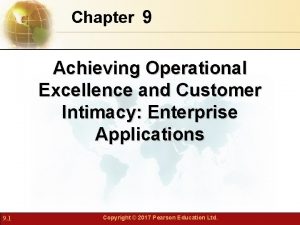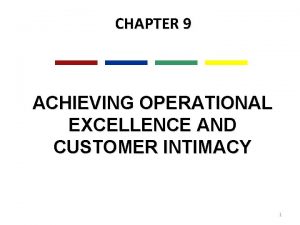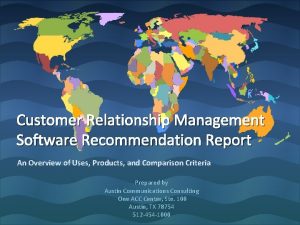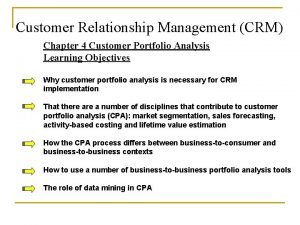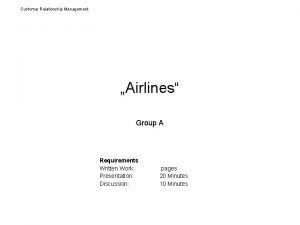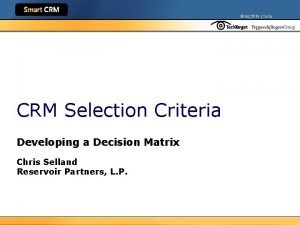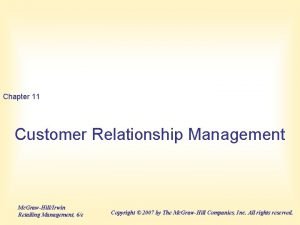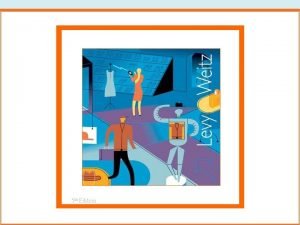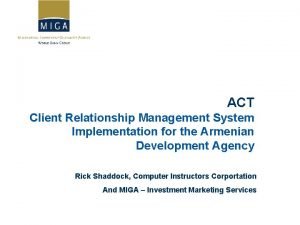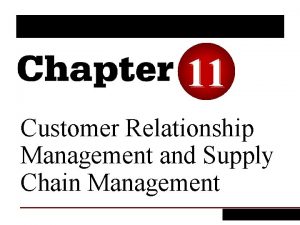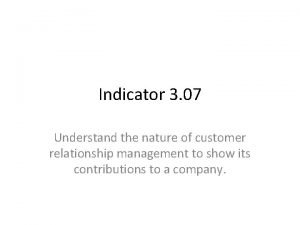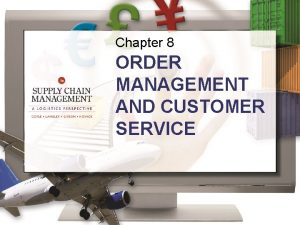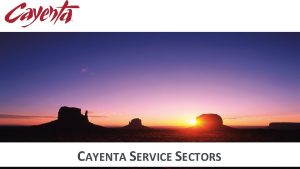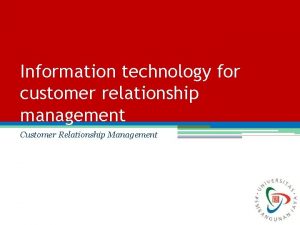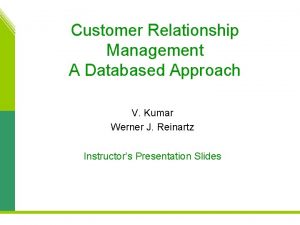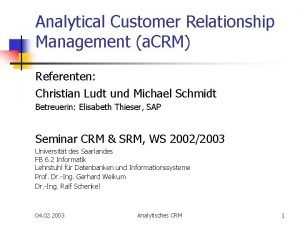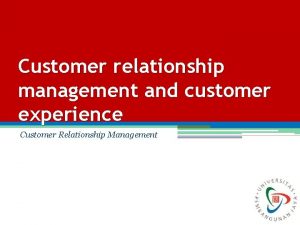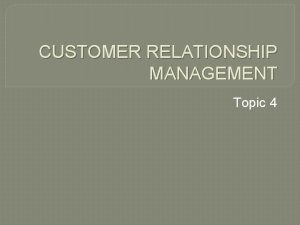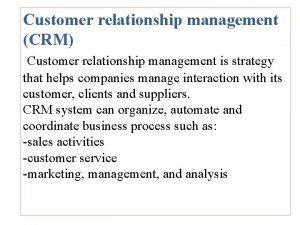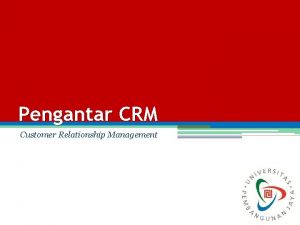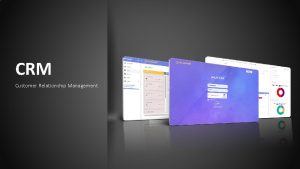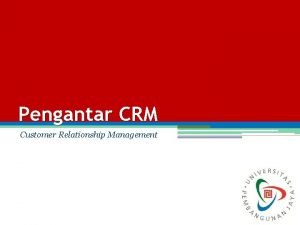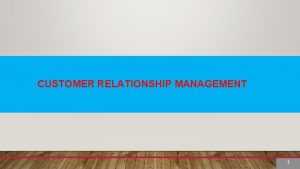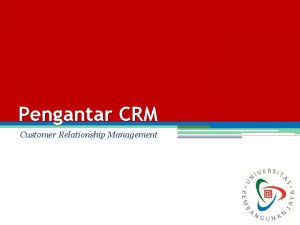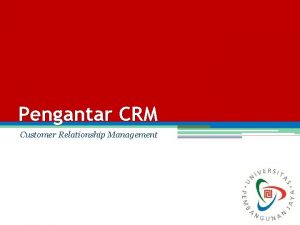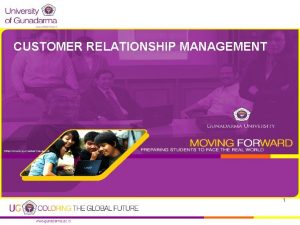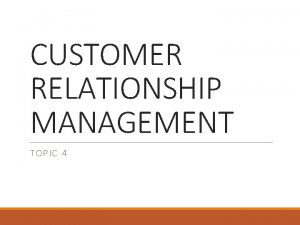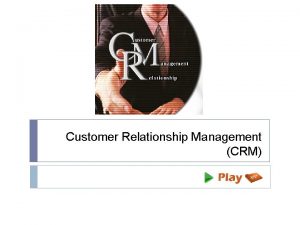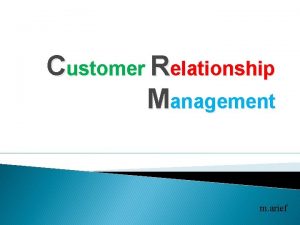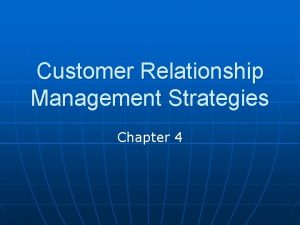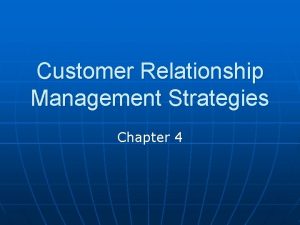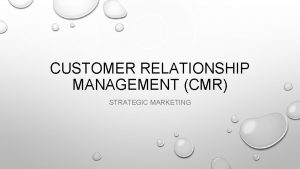Customer relationship management Lecture 10 Customer Relationship Management




















- Slides: 20

Customer relationship management. Lecture 10

Customer Relationship Management (CRM): the business elements of the system

CRM: steps to success Successful organizations use three steps to build customer relationships: • determine mutually satisfying goals between organization and customers • establish and maintain customer rapport • produce positive “feelings” in the organization and the customers

Customer Relationship Management (CRM) Information Systems • Capture, consolidate, analyze customer data and distribute results to various systems and customer touch points (contact points) across enterprise • Provide single enterprise view of customers • Provide analytical tools for determining value, loyalty, profitability of customers • Assist in acquiring new customers, providing better service and support to customers, customize offerings to customer preferences, provide ongoing value to retain profitable customers • Provide customers with a single view of the enterprise at touch points (web-site ): What would you consider important in the design of this points of contact

CRM I. T. software • Ranges from niche tools to large-scale enterprise applications • Typically include tools for sales, customer service, and marketing • CRM I. T. system should include: • Partner relationship management (PRM) modules • Enhances collaboration between company and selling partners • Employee relationship management (ERM) modules • Deals with employee issues closely related to CRM, e. g. setting objectives, employee performance management

Sales force automation (SFA) modules • Enable focusing efforts on most profitable customers • Enables sharing customer and prospective customer information (what other type of application/technology may be used in conjunction with this) • Helps reduce cost per sale and cost of acquiring, and retaining customers

Customer service modules • Assigning and managing customer service requests • E. g. managing advice phone lines, Web site support

Marketing modules • Capturing prospect and customer data, • Providing product and service information • Qualifying (determining) leads for targeted marketing • Scheduling and tracking direct-marketing mailings or e-mail

Analysing customer and marketing data • Identifying profitable and unprofitable customers • Designing products and services to satisfy specific customer needs and interests (niche products) • Identifying opportunities for cross-dressing

Customer Loyalty Management Process Map

Two main categories of CRM • Operational CRM – Customer-facing applications, e. g. tools for sales force automation, call centre and customer service support, marketing automation • Analytical CRM – Applications that analyse (OLAP, data mining, etc. ) customer data – Based on data warehouses consolidating data from operational CRM systems and customer touch points – One important output: Customer lifetime value (CLTV) – Value based on revenue produced by a customer, expenses incurred in acquiring and servicing customer, and expected life of relationship between customer and company

Analytical CRM data warehouse

Business value of CRM • • • Increased customer satisfaction Reduced direct marketing costs More effective marketing Lower costs for customer acquisition and retention Increased sales revenue • By identifying profitable customers and segments for focused marketing and cross-selling • Reduced churn rate (number of customers who stop using or purchasing products or services): indication of customer dissatisfaction

Advantages • "Cross Sell" and "Up Sell" Products More Effectively – CRM systems facilitate cross-selling (offering customers complimentary products based on their previous purchases) and up-selling (offering customers premium products in the same category). – It helps them to gain a better understanding of customers and anticipate their purchases (e. g. someone who purchases grass seed in the spring will need fertilizer later in the season). • Help Sales Staff Close Deals Faster – CRM helps the businesses in closing deals faster, through quicker and more efficient responses to customer leads and customer information. – The turnaround time has decreased drastically for organisations that have been able to implement CRM systems effectively. • Make Call Centres More Efficient – With each employee having access to customer details and order histories, targeting clients becomes easier. – CRM helps the organisation's workforce in knowing how to deal with each individual customer depending upon the customer's archives available through CRM. The information can be accessed instantly from anywhere within the company.

Advantages • Discover New Customers – CRM systems help the organisation in identifying potential customers. By keeping a track of the profiles of their existing clientele, the business can easily come up with a strategy to determine the kind of people they should target such that it returns them maximum opportunity. – For example, if several students in a university sign up for a particular mobile service provider, the business can come up with a strategy to target rest of the community in the university. • Simplify Marketing And Sales Processes – CRM helps in developing better communication channels. Interactive Voice Response System, web sites, etc. have made life easy both for the organisation and also for its sales representatives. – It allows the business to give its customers the option of choosing how they want to communication with the business.

Case study: Londis • Enhancing and maintaining service levels to ADM Londis retailers necessitated wider corporate engagement in resolving customer queries, as well as to give managers the ability to view the number and status of departmental queries • As part of a € 3 million supply chain initiative to deliver improved service levels to retailers, the company decided to implement a CRM system in 2010

Case study (2) • Prior to the CRM implementation, the group had defined service level targets, but had been unable to accurately measure how successful it had been in terms of meeting those targets. • The CRM system provided up to the minute views on how effectively queries were being resolved.

Case study(3) • After implementation service levels improved from 95% to 99% satisfaction rating • The next phase of the CRM project will be to deliver a self service solution via the web to the retailers. This enhancement will allow retailers to log their own calls at any time of the day or night, to facilitate the needs of retailers who are under immense time pressure. • The retailers will also be able to check the status of their query, which helps to build and maintain a close trusting relationship.

I. T. technology • What type of C. R. M system are Londis implementing (operational / analytical) • What type of information is captured by the londis C. R. M. information system. • How you would use decision technology to improve the trusting relationship between londis and their customers.

Sample question • What is meant by the term: customer relationship management (C. R. M. )? (3 marks) • • What are the ideal characteristics of a customer relationship management information system? (5 marks) • • What are the main elements of the analytical and operational CRM software? (6 marks) • • Explain, using suitable examples, ways that the operational and the analytical C. R. M systems contribute added (financial and strategic) value to the business. (16 marks)
 Customer relationship management and customer intimacy
Customer relationship management and customer intimacy Customer relationship management and customer intimacy
Customer relationship management and customer intimacy Intimacy
Intimacy 01:640:244 lecture notes - lecture 15: plat, idah, farad
01:640:244 lecture notes - lecture 15: plat, idah, farad Crm and scm
Crm and scm Software recommendation report
Software recommendation report Customer relationship management training ppt
Customer relationship management training ppt Pengertian bcg matrix
Pengertian bcg matrix Airline customer relationship management
Airline customer relationship management Customer relationship management matrix
Customer relationship management matrix Crm process in retailing
Crm process in retailing Customer relationship management in retailing ppt
Customer relationship management in retailing ppt Act client database
Act client database Customer relationship management in supply chain
Customer relationship management in supply chain Nature of customer relationship management
Nature of customer relationship management Order management & customer service relationship concept
Order management & customer service relationship concept Cayenta enterprise resource planning
Cayenta enterprise resource planning Crm and information technology
Crm and information technology Rfm
Rfm Analytical customer relationship management
Analytical customer relationship management Sugar customer relationship management
Sugar customer relationship management

